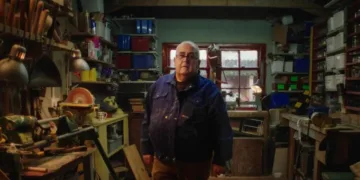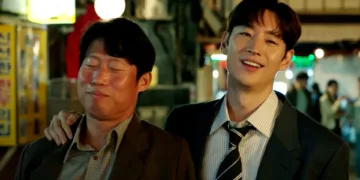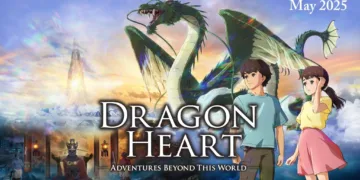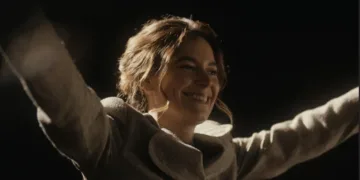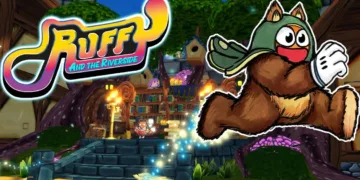In The Buildout, Zeshaan Younus’s feature debut, a lean 64-minute indie unfolds as a hybrid of narrative drama and fragmentary found-footage realism. The format alternates between meticulously framed widescreen vistas and jittery camcorder segments (a style I might dub “docu-lyricism”), courtesy of GoPro helmet cams and a handheld consumer camera.
Against the Southern California desert’s bleached expanse, Cameron (Jenna Kanell) and Dylan (Hannah Alline) undertake one last desert trek toward a fledgling religious community. Both bear the aftermath of a shared loss—guilt-laden and aching for absolution.
Younus orchestrates a contemplative pulse, where long silences stretch like dunes, then snap into sudden, unsettling suggestion. The film’s rhythm recalls post-war pilgrim narratives—those seeking a new Eden amid dust and doubt. It even seems to echo Steinbeck’s dust-blown migrations: survivors gravitating toward the promise of renewal.
In this milieu, themes of rebirth and rupture entwine. Friendship is tested under relentless sun; grief simmers alongside budding hope. And faith, rendered in sporadic bursts—whispered prayers captured on trembling tape—remains tantalizingly out of reach (or is it our own longing projected onto the dunes?). Something stirs beneath those sands. Or perhaps we only want to believe it does.
Contours of Belief and Loss
The Buildout opens with terse voiceover diaries—grainy field logs that drip just enough world-building to hook us (call it “mystery by omission”). We’re dropped into a desert migration that echoes 1930s Dust Bowl exoduses—families chasing hope across parched earth—except here the pilgrims hunt a spiritual hotspot rather than arable land.
Younus then shunts us to a quasi-scientific prologue: a female researcher catalogues strange readings before being abruptly sent home. Suddenly, we’re alongside Cameron and Dylan on their dusty trek—and the film’s dual timelines click together like tectonic plates.
Dylan’s decision to join The Clergy is fueled by grief therapy and rehab-style milestones—her sister’s death a catalyst for seeking a new communal identity. Cameron accompanies her, torn between supporting recovery and confronting a ritualistic community she neither trusts nor fully dismisses. Their objectives diverge (salvation vs. skepticism), yet both are vulnerable under the desert sun. It’s a classic fork-in-the-road scenario, except the terrain is as psychological as it is geographical.
Tension ratchets up along jagged emotional arcs: one moment the duo share elated banter, the next bitterness flares like roadside fires. The film’s rhythm is jagged—joy abruptly curdles into frustration. Then the first supernatural cameo—a blink on a GoPro—squeezes through the realism, warping the documentary veneer and turning sand into stagecraft.
At the apex, shadows bloom in the heat: camcorder footage freezes on shapes that might be divine or delusional. The friends’ bond frays under cosmic suggestion, yet Younus refuses to deliver a tidy reveal. Instead, we’re left in an echo chamber of questions (peak ambiguity by design).
Beneath the shifting sands lie three core motifs: friendship tested by shared loss; the collision of fervent faith with hard-nosed atheism; and the act of self-recording—helmet cams, diary logs—emerging as trauma-poetics, a mechanism to narrate, exorcise, and preserve memory within an indifferent wasteland.
Embodied Echoes: Performance as Paleontology
Hannah Alline’s Dylan is a living archive of trauma—what I’d call “grief sediment”—layered in every furtive glance and halting confession. She begins as a vulnerable recovering addict, shoulders hunched beneath invisible weights, and slowly unfurls into a seeker whose hope feels almost radar-like: probing the desert’s emptiness for signals.
In one standout monologue (midway through the GoPro footage), Dylan speaks directly to the camera, voice quavering as she recounts a memory of her late friend. It’s a jolting reminder that documentary-style framing can amplify raw confession—an intimate confession booth taped to a motorbike helmet.
Jenna Kanell’s Cameron, by contrast, is a study in controlled volatility. Picture an archetype forged in Midwestern no-nonsense steel, softened only by the ache of her sister’s ghost. Her loyalty glints in playful banter—jokes tossed like survival kits across the dunes—yet resentment flickers in tight-lipped side-eyes when grief resurfaces. Kanell nails those tonal shifts: one moment cracking wise about engine trouble, the next slamming a silent wall between herself and Dylan. It’s sibling rivalry reframed as friendship friction, pointing to larger societal tensions between individual autonomy and communal obedience.
Natasha Halevi’s Cleric Kanner embodies The Clergy’s spiritual conviction with a soft intensity—her voiceovers fluttering in and out like hymns on a broken radio. She never overplays the zealot; instead, her conviction resembles historical figures who promise Eden but deliver exile. Likewise, Michael Sung-Ho’s Cleric Barrow appears only in found-footage snippets—a phantom presence whose brief diary entries cast long shadows.
Together, the ensemble threads realism into the supernatural tapestry. When minor figures drift through the frame—surveying equipment, new recruits muttering prayers—they risk flattening into “stock-photo cultists.” But more often, their fleeting cameos underscore the paradox of group identity: both suffocating and sustaining. Through these performances, The Buildout gestures toward a broader cultural reckoning—our collective yearning for belonging amid desertified modern life.
The Desert as Lens
Justin Moore’s widescreen compositions treat the desert as a living specter—an expanse so vast it seems to inhale the characters’ doubts. His “airy” meditative spaces recall the open horizons of 1960s Westerns, yet here the frontier feels spiritual rather than territorial (a kind of modern Manifest Destiny writ small). Aerial drone sweeps evoke both grandeur and surveillance, while ground-level shots ground us in gritty detail: wind-swept sand, tire tracks, the slow drift of light.
Found-footage segments puncture Moore’s pristine frames: helmet cams and a battered camcorder supply jittery intimacy. They arrive at irregular intervals, like secret communes of the image world—brief portals into first-person unease. Just when the grainy, claustrophobic POV feels permanent, the film snaps back to polished close-ups, jolting us out of that trance. It’s visual jujitsu—subverting our desire for a single “truth” camera.
Characters often stand dwarfed by the landscape, a compositional choice that underscores isolation and awe in equal measure. Framing them as small figures against vast emptiness echoes post-Roaring Twenties paintings of American desolation (think Edward Hopper’s lonely figures). Subjective GoPro footage offers a counterpoint: these people own their narratives, even as the world swallows them.
Rhythm emerges through editing. Dirt-bike sequences move at a deliberate clip—less spectacle, more grounding ritual. The cut from roaring engines to diary-log voiceovers creates temporal dissonance, reminding us that memory and reality cohabit uneasily. Intercutting between archival-style logs and present drama tightens suspense, as if each edit were a heartbeat measured against the desert’s timeless pulse.
Echoes in the Expanse
The score in The Buildout skulks in the corners of scenes, shifting the mood from intimate drama to subtle thriller (I’d call it “tension minimalism”). Sparse pulses of low-register strings and echoing drones ripple through wide desert shots—reminding us that the landscape itself might be listening. When the music arrives, it feels like a sudden gust of wind: unsettling, yet oddly natural.
During the dirt-bike passages, the film strips away nonessential music, letting the hiss of wind against the GoPro and gravel crunch under tires dominate. These ambient sounds become sculptural, carving out memory loci in our minds. It’s akin to climate-change documentaries that use raw field audio to underscore ecological fragility—only here, vulnerability is human rather than planetary.
Diegetic audio anchors us further. Dylan’s camcorder picks up whispered prayers; Cameron’s laughter cracks through engine roar. Footsteps on sand, a distant bird call—each element calibrated for authenticity. Even the voiceover logs are mixed with gentle tape hiss, evoking mid-century radio broadcasts (a “sonic palimpsest,” perhaps).
Off-screen sounds punctuate the narrative: a faint chant, a wind-whipped murmur from beyond the frame. These moments function like historical radio warnings—suggesting unseen threats without spelling them out. Sound bridges stitch voiceovers to present action, maintaining the film’s trancelike pulse. In these choices, Younus crafts an aural landscape as vast—and as psychologically fraught—as the desert itself.
The Alchemy of Form
Younus’s genre-ambivalence flirts with horror and sci-fi tropes yet refuses to deliver jump scares (a bold move in an age of trailer-driven shock tactics). The pacing often drifts like a contemplative art-house reverie—Tarkovskyan patience meets Malickian lyricism—inviting viewers to sit with unease rather than bolt from their seats.
Found-footage elements surface sparingly: helmet-cam jolts and camcorder whispers puncture the film’s composed stillness. It’s a measured restraint (I’d call it “docu-reflection”), never ceding full control to POV conventions. As a result, clarity and disorientation trade places—just when we settle into a raw, first-person intimacy, the camera pulls back into widescreen contemplation.
This directorial debut reveals a keen visual sensibility: Younus marries desert grandeur with intimate character drama, crafting shots that simmer with both isolation and invitation. Yet moments of narrative thinness appear—cult motivations sometimes feel sketched, not carved. The craving for deeper context lingers.
Clocking in at 64 minutes, the script is lean. Dialogue often lands like sharpened tools, cutting swiftly to the bone. And then—wham—a supernatural tease arrives with the speed of a desert storm, leaving us craving both more and less. It’s concise filmmaking that occasionally cuts too close to ambiguity’s edge. Yet perhaps that razor’s edge is precisely the point.
Verdict Among the Dunes
To recap, The Buildout shines most brightly in its lead performances (Alline and Kanell’s raw chemistry feels like a desert mirage you want to believe in) and in Justin Moore’s hypnotic cinematography, which renders the landscape a caracteur in its own right. The film’s thematic exploration of grief and friendship resonates with cultural moments when communities seek refuge in shared narratives (think modern-day digital echo chambers).
Yet Younus’s deliberate opacity can feel exasperating. The supernatural threads hover like dust devils—provocative, yes, but never grounded in enough context to fully satisfy our curiosity. Some viewers might relish that unanswered ambiguity; others could find themselves longing for a firmer foothold in the cult’s mythology.
Despite these narrative gaps, The Buildout ultimately functions as a promising meditation on belief, memory, and connection. It may frustrate those craving a neat reveal, but it also rewards an open mind willing to dwell in uncertainty.
In its modest 64-minute span, Younus stakes out a distinctive voice—a meditative genre hybrid that hints at greater depths yet to come. Whether it becomes a cult classic or a desert footnote may depend on how audiences embrace its uncharted territories.
Full Credits
Director: Zeshaan Younus
Writer: Zeshaan Younus
Producers: Trevor Dillon, Sailor Larocque, Nicholas Thurkettle, Zeshaan Younus
Cast: Jenna Kanell, Hannah Alline, Natasha Halevi, Michael Sung-Ho, Danielle Evon Ploeger, Ariel Barber
Director of Photography (Cinematographer): Justin Moore
Editor: Matt Latham
The Review
The Buildout
The Buildout hangs its mystery like a mirage, rewarding patience but leaving some craving more substance. Its lead performances and desert metaphysics mark Zeshaan Younus as a director worth watching.
PROS
- Compelling lead chemistry between Alline and Kanell
- Hypnotic desert cinematography that doubles as character
- Meditative pacing that invites reflection
- Innovative mix of found-footage and narrative drama
CONS
- Cult mythology remains frustratingly vague
- Occasional narrative thinness in supernatural threads
- Short 64-minute runtime leaves some beats underexplored
- Pacing can jerk between serenity and tension



























